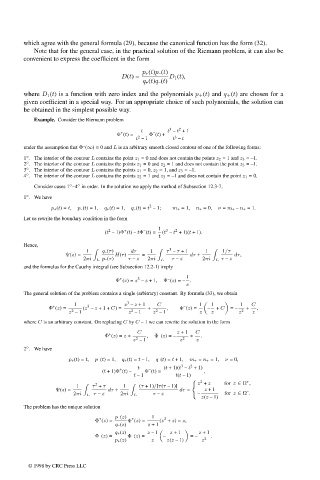Page 631 - Handbook Of Integral Equations
P. 631
which agree with the general formula (29), because the canonical function has the form (32).
Note that for the general case, in the practical solution of the Riemann problem, it can also be
convenient to express the coefficient in the form
p + (t)p – (t)
D(t)= D 1 (t),
q + (t)q – (t)
where D 1 (t) is a function with zero index and the polynomials p ± (t) and q ± (t) are chosen for a
given coefficient in a special way. For an appropriate choice of such polynomials, the solution can
be obtained in the simplest possible way.
Example. Consider the Riemann problem
2
3
t t – t +1
–
+
Φ (t)= Φ (t)+
t – 1 t – t
3
2
–
under the assumption that Φ (∞)=0 and L is an arbitrary smooth closed contour of one of the following forms:
1 . The interior of the contour L contains the point z 1 = 0 and does not contain the points z 2 = 1 and z 3 = –1.
◦
◦
2 . The interior of the contour L contains the points z 1 = 0 and z 2 = 1 and does not contain the point z 3 = –1.
◦
3 . The interior of the contour L contains the points z 1 =0, z 2 = 1, and z 3 = –1.
◦
4 . The interior of the contour L contains the points z 2 = 1 and z 3 = –1 and does not contain the point z 1 =0.
◦
◦
Consider cases 1 –4 in order. In the solution we apply the method of Subsection 12.3-7.
◦
1 .We have
2
p +(t)= t, p –(t)=1, q +(t)=1, q –(t)= t – 1; m + =1, n + =0, ν = m + – n + =1.
Let us rewrite the boundary condition in the form
1
2
3
–
+
2
(t – 1)Φ (t) – tΦ (t)= (t – t + 1)(t + 1).
t
Hence,
3
1 q –(τ) dτ 1 τ – τ +1 1 1/τ
Ψ(z)= H(τ) = dτ + dτ,
2πi L p –(τ) τ – z 2πi L τ – z 2πi L τ – z
and the formulas for the Cauchy integral (see Subsection 12.2-1) imply
1
+
3
–
Ψ (z)= z – z +1, Ψ (z)= – .
z
The general solution of the problem contains a single (arbitrary) constant. By formula (33), we obtain
3
1 z – z +1 C 1 1 1 C
+
–
3
Φ (z)= (z – z +1+ C)= + , Φ (z)= – + C = – + ,
2
2
2
z – 1 z – 1 z – 1 z z z 2 z
where C is an arbitrary constant. On replacing C by C – 1 we can rewrite the solution in the form
C z +1 C
+
–
Φ (z)= z + , Φ (z)= – + .
2
z – 1 z 2 z
2 .We have
◦
p +(t)= t, p –(t)=1, q +(t)= t – 1, q –(t)= t +1, m + = n + =1, ν =0,
3
2
t (t + 1)(t – t +1)
–
+
(t +1)Φ (t) – Φ (t)= ,
t – 1 t(t – 1)
2 +
2
1 τ + τ 1 (τ +1)/[τ(τ – 1)] z + z for z ∈ Ω ,
Ψ(z)= dτ + dτ = z +1 –
2πi L τ – z 2πi L τ – z – for z ∈ Ω .
z(z – 1)
The problem has the unique solution
p –(z) 1
+
2
+
Φ (z)= Φ (z)= (z + z)= z,
q –(z) z +1
q +(z) z – 1 z +1 z +1
–
–
Φ (z)= Φ (z)= – = – .
p +(z) z z(z – 1) z 2
© 1998 by CRC Press LLC
© 1998 by CRC Press LLC
Page 614

